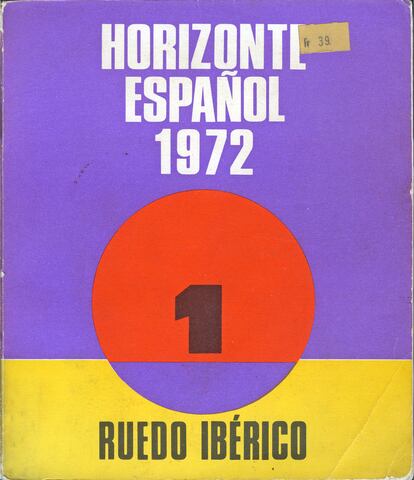“It is my will that the content of this suitcase and the content in slide photos and (digital) CDs of the whole house BURN thoroughly and completely”, wrote Jorge Rueda (Almería, 1943 − Jorox, 2011) in April 2010, on a simple sheet of yellow and squared paper that incorporated his letterhead.
“I include framed photos.
That is, ALL photos and negatives.
Except for books and catalogs ”.
On December 13, 2011, just a month after the photographer's death, his mandate was fulfilled in the yard of his house in Jorox.
A devastating cancer ended the life of one of the most unique and provocative actors on the photography scene in Spain.
An inescapable reference during the eighties, he was able to breathe a breath of fresh, transgressive, colorful and imaginative air into a photograph anchored in the tradition of the great masters of black and white documentary photography of the 1950s.
His innovative spirit went beyond the development of his personal work, giving impetus to new narratives through his outstanding role as founder and director of
Nueva Lente
magazine
.
Thus, that bonfire that burned in the courtyard of his house in Jorox placed the institutions that work with photography in the spotlight, and pointed out their ineffectiveness when it came to protecting, ordering and preserving a valuable archive.
Although at the last minute there was some attempt to save him, it was already too late.
PHOTO GALLERY: Jorge Rueda: "Except for books and catalogs"
What was saved from the pyre (images and texts that remain in print in books, magazines and catalogs, publications, and that range from the hectic sixties to the present day) constitutes the starting point of the
Salvo Libros y Catalogs project
.
A research work in progress, directed by Julián Barón and Rocío Gutiérrez, a journey after the figure of Rueda through four decades of photography editing in Spain.
Its development has led to the creation of a cataloging fund, carried out by Lucía Osuna.
It constitutes the documentary basis for a debate on the photographic medium and its edition and highlights the value of the publication as a reference and legacy.
The initiative has been carried out in collaboration with the Fiebre Photobook platform, on whose website you can see the virtual exhibition of said project, which will culminate in a publication consisting of two volumes.
“I was attracted to Jorge Rueda by his unfolding as a photographer and editor, as well as his capacity for criticism and reflection from theory,” says Barón.
And he adds: "Hence, we find it very interesting to also trace the theoretical body that he had left throughout his career."
A fruitful career in which, to his already mentioned work at the head of
Nueva Lente
magazine
,
is added that of founder of the magazine
Aqui Imagen
;
his time as a graphic editor for
Triunfo
magazine
;
his collaborations with foreign publishers such as Ruedo Ibérico, Hatier and Panorama;
his collaborations in that iconoclastic space born during the Movida that was
La Luna de Madrid
, and also in
El Paseante
.
'Spanish horizon 1972', supplement to 'Cuadernos de Ruedo ibérico'.
Cover of José Martínez.
COURTESY FEVER
He was director of the Andalusian Photographic Encounters and member of editions of the Royal Photographic Society of Madrid.
There were three monographs dedicated to his work:
Mal de ojos
(Mestizo),
Desatinos
(University of Malaga) and
Human
(Lunwer).
In 1976 he was commissioned to curate an exhibition on Spanish photography at the Arles Encounters.
It would be the first international exhibition after Franco's death, and it included members of the so-called Fifth Generation, representatives of the most avant-garde trends of the moment.
"Rueda had a very particular way of understanding the world that he led to its ultimate consequences," says Barón.
“He was an observer capable of bringing many photographers to the fore.
He continuously practiced the exercise of freedom through a critical view of the world, but also very respectful.
Ahead of his time, he was a forerunner of digital photo montage, a pioneer when it came to incorporating tools such as Photoshop and using Facebook ”.
For the great communicator that Rueda was, the primary value of photography was in its reproducibility, “in the fact that it was born to be disseminated to the maximum in contrast to painting.
He said that he preferred to sell a million images for one euro than a single image for a million ”, highlights Gutiérrez, who collaborated on several occasions with the author.
"He was never interested in photography as an object to be exhibited in a gallery or museum, hence his interest in printed editions, which, demanding, he always took care of in search of the highest quality."
Thus, in
Mal de ojos, he
invites the reader to take any image from the book, cut the perforated edge of the worm, and hang it like a work.
"They are not reproductions, they are original in the precise sense of the word, although there is much more than one", stressed the author.
"He was never interested in photography as an object to be exhibited in a gallery or museum"
He liked to work in an unorthodox way.
Experimentation formed the basis of his artistic endeavor.
Self-taught, he defined himself as “a slob who has fun taking photos”, and yet he had great control over his technique.
His photomontages, "made from his own photographic productions, portraits, reports and elements of reality, become visual metaphors that do not dissociate the documentary importance of the photographic fact as a creator", highlighted the photographer Félix Lorrio during the meeting organized during the last Fiebre 2020 festival around the figure of Rueda.
His images of saturated colors, charged with an acid and corrosive humor, and often disrespectful to established standards, revealed a fantastic universe.
Thus he came to be considered the father of Spanish surrealism, something with which he did not agree, since he framed his work within fantastic realism.
"And if he is the father, where are his children?"
“Is today's photography lacking in humor?” Asked the collector and photobook expert Gabriela Cendoya during the meeting held in Fiebre.
He had a reputation for being demanding and selective.
“Not everything was valid for him.
He defended that a photographer should know how to work for the medium in which he shows his images, both in the digital and printed edition, aware of the need for visual criteria when practicing photography, ”says Rocío Gutiérrez.
When it came to recognizing the photographic and expressive value, the author went beyond his own taste, incorporating new voices that made photography evolve in Spain.
"When saving books and publications, Jorge Rueda was consistent with his voice," says Gutiérrez.
The act itself gave a value to their publications, at a time when this type of support was gaining value compared to photographic copying and was beginning to find its place in documentation centers and museums.
“He left us a valuable legacy.
The sad thing is that the problems we complain about today, within the field of photography in Spain, are the same ones that Rueda echoed then, ”says Barón.
"We must not forget where we come from so that together we can figure out where we are going."
Except books and catalogs.
Virtual exhibition on the Fiebre Photobook platform.
You can follow BABELIA on
and
, or sign up here to receive
our weekly newsletter
.



/cloudfront-eu-central-1.images.arcpublishing.com/prisa/BJP24JNYMRDX3JV4YKTWR4PEWY.jpg)
/cloudfront-eu-central-1.images.arcpublishing.com/prisa/FS5FDPA2QFAPPP3M22RRTDN2II.jpg)

/cloudfront-eu-central-1.images.arcpublishing.com/prisa/YXNLCBNSQNBOHPH3UKP6VN463I.jpg)
/cloudfront-eu-central-1.images.arcpublishing.com/prisa/CAQ75OKMMBC7BORFCV6MOXDMWQ.jpg)







